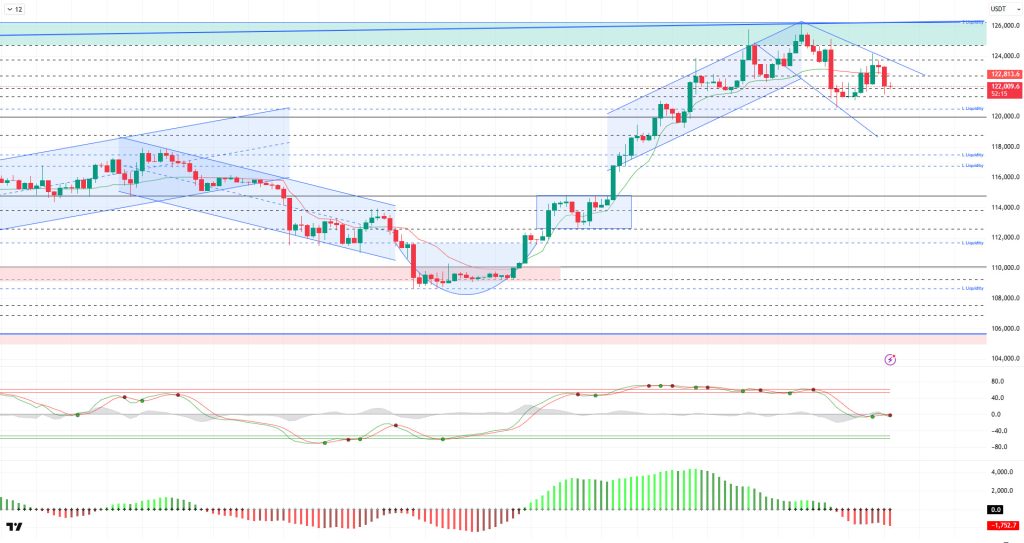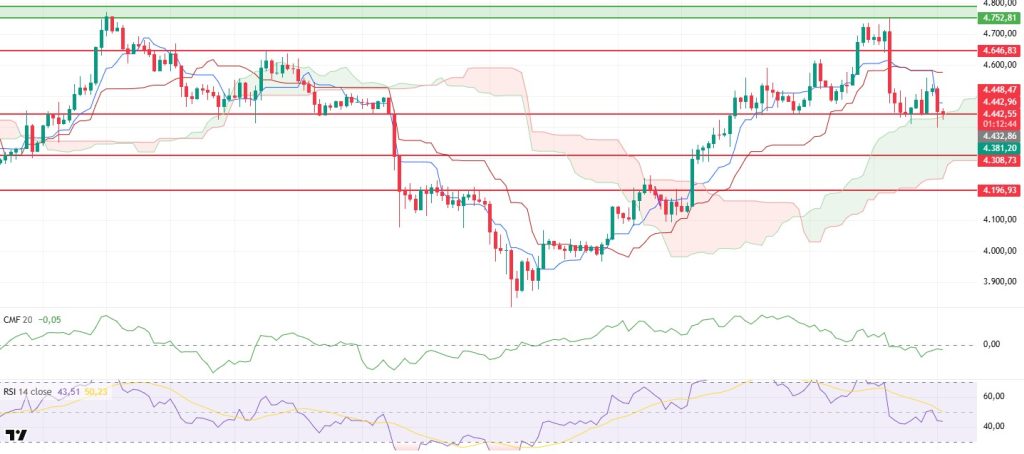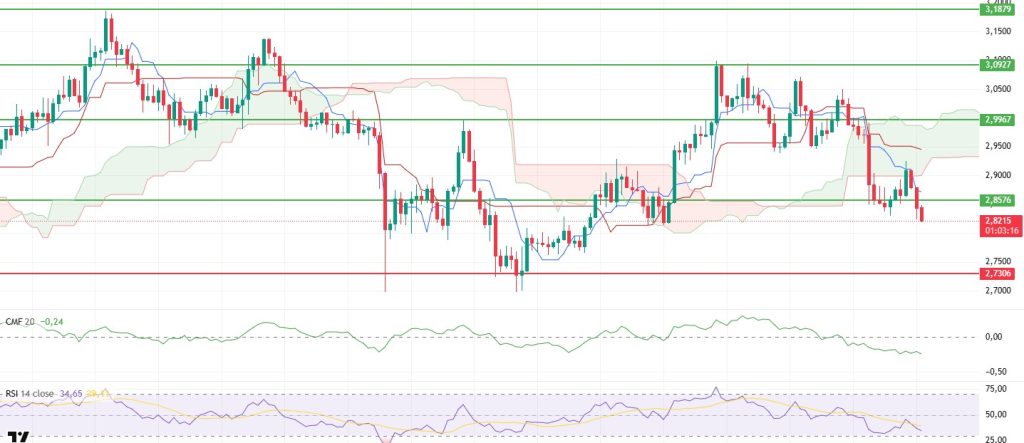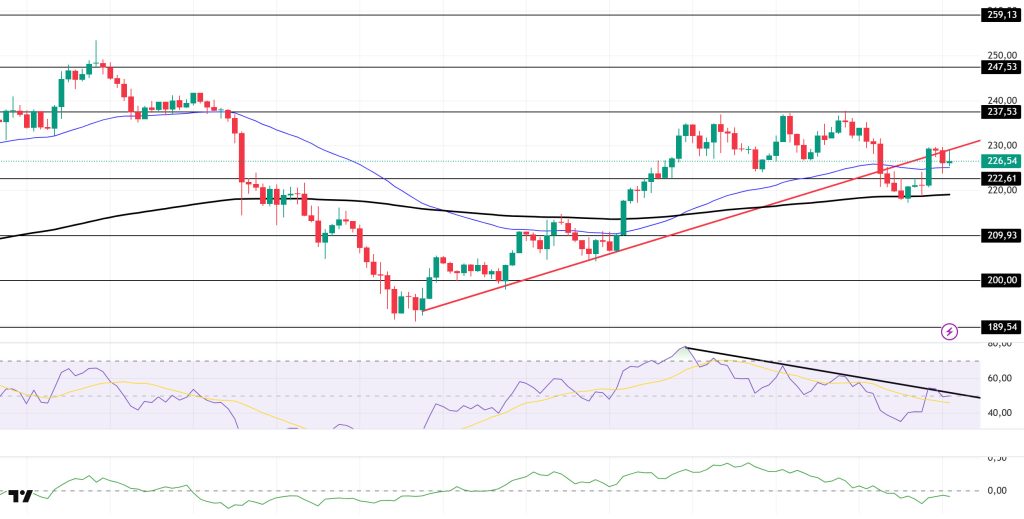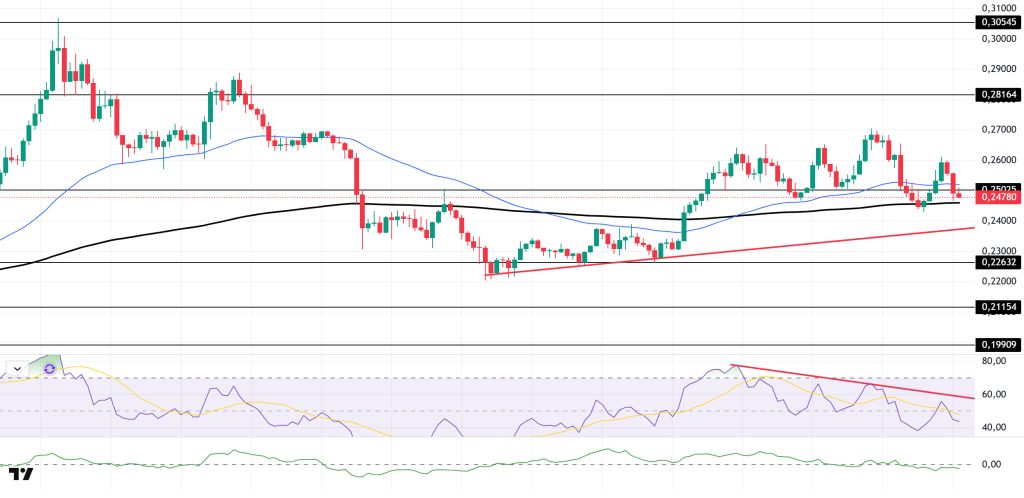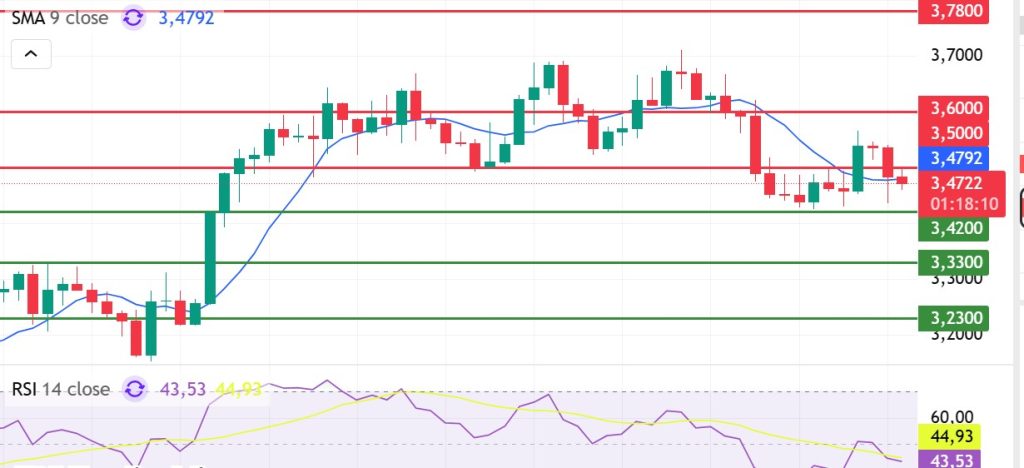Technical Analysis
BTC/USDT
As the US government shutdown entered its second week, Fed minutes highlighted uncertainties regarding monetary policy. The minutes revealed significant disagreements among members regarding interest rate cuts, with the probability of a 25-basis-point cut in October exceeding 94%. Local investor interest in the Treasury’s 10-year bond auction increased, while foreign demand weakened. The budget impasse continues as the Senate rejected the temporary funding bill for the sixth time. Meanwhile, Russia reported that diplomatic momentum with the US had been lost following the Alaska summit.
Looking at the technical picture, BTC broke its short-term upward trend by correcting after its second peak attempt at 126,198. While volatility increased in BTC, which formed a flag pattern close to its ATH level, it appears to be forcing futures to close. In the previous analysis, the price, which had fallen to the 121,500 level, tested the 124,200 level. Then, BTC, which turned downward again, continues to trade at the 121,900 level.
Technical indicators show that the Wave Trend (WT) oscillator converted its short-term buy signal in the channel middle band into a sell signal. The Squeeze Momentum (SM) indicator’s histogram moved into negative territory with the latest decline. The Kaufman moving average is currently trading above the price at the 122,800 level.
Looking at liquidation data, the sell-off has started to reappear with the recent upward movement, and there has been heavy accumulation at the 126,400 level in the long term. Positions at the 122,500 – 122,900 levels in the short term were liquidated. In contrast, increased intensity at the 120,500 level, which is the buying level, is observed. Additionally, buying intensity continues at the 117,800 and 116,600 levels.
In summary, the rise in BTC on the fundamental side is supported by institutional demand for ETFs, the impact of expectations for Fed interest rate cuts, correlation with gold, and cyclical movements in October. The technical outlook reached saturation point with the price testing the 126,198 ATH level, while liquidity data was the factor driving the price correction. After this stage, if selling pressure deepens, 120,500 will be monitored as a critical reference area. A break below this level could push the price towards liquidity areas and deepen selling pressure. If the rise continues, 122,700 will be the resistance area.
Supports: 121,400 – 120,500 – 119,000
Resistances: 122,700 – 124,300 – 125,700
ETH/USDT
After rising to $4,540 yesterday evening, the Ethereum price retreated from this level due to strong selling pressure and fell back to $4,401. The price is currently trying to hold on to the upper band of the cloud. While the market continues to seek equilibrium in this area, technical indicators show that selling pressure will remain effective in the short term.
The Relative Strength Index (RSI) indicator continues its downward movement after being rejected from the 50 level. This outlook reveals that market momentum has weakened significantly and buying pressure has decreased. The RSI remaining at these levels means that rebound buying could be limited and the price could face resistance in short-term recovery attempts.
Although the Chaikin Money Flow (CMF) indicator has recovered somewhat after previous declines, it remains in negative territory. This weakness in liquidity flow indicates that new capital inflows are insufficient and investors are avoiding risk. The CMF remaining in negative territory confirms that selling pressure is still dominant in the market and that the price has failed to gain strong upward momentum.
The overall structure of the Ichimoku indicator has not changed. The price continues to trade below the Tenkan and Kijun levels, while the Tenkan crossing below the Kijun supports the bearish outlook in the short term. However, the price still being above the kumo cloud indicates that the overall trend retains its positive structure and that the long-term upward trend has not yet been broken.
As long as the price remains below the $4,442 level, the possibility of a gradual pullback towards the $4,308 region is increasing. On the other hand, if the price regains the $4,646 level, it will indicate that short-term selling pressure has eased and the market has begun to enter a recovery phase. If buyers manage to maintain stability above this level, it could pave the way for the price to head back towards the $4,700 region.
Supports: 4,442 – 4,308 – 4,196
Resistances: 4,646 – 4,752 – 4,857
XRP/USDT
The XRP price showed a slight recovery yesterday evening, reaching the $2.92 level and briefly entering the kumo cloud. However, this rise was not sustainable. Due to the impact of increasing liquidity outflows, a sharp sell-off occurred in the morning hours, and the price broke below the $2.8576 support level, falling to $2.82. This movement reveals that selling pressure has intensified and buyers have largely lost their influence in the market.
The Chaikin Money Flow (CMF) indicator continues its decline in negative territory, confirming that capital outflows from the market are continuing unabated. The CMF remaining in this zone indicates that an upward recovery will struggle to find support and that the selling side still holds control.
The Relative Strength Index (RSI) indicator is showing a very weak picture, continuing its decline towards the oversold zone. This picture reveals that market momentum has completely weakened and buyers are reluctant to re-enter the market. The RSI remaining at these levels indicates that any potential rebound buying in the short term will be limited.
The overall structure of the Ichimoku indicator remains unchanged. The price falling below the kumo cloud clearly shows that the general trend has turned negative and sellers remain in control. The price staying below the Tenkan and Kijun levels confirms that downward pressure continues.
In the overall outlook, as long as the price fails to hold above the $2.8576 level, the risk of a pullback towards the $2.73 level increases. On the other hand, if the price regains the $2.8576 level, it could signal that the downward momentum is weakening and that a limited recovery could begin in the short term.
Supports: 2.7306 – 2.6513 – 2.4730
Resistances: 2.8576 – 2.9967 – 3.0927
SOL/USDT
Bitwise updated its Solana fund application by adding “Staking” and set a low sponsorship fee of 0.20%.
The SOL price experienced a slight increase. The asset continues to be in the lower region of the upward trend that began on September 26. This could increase selling pressure. The price, which crossed over to the upper region of the 50 EMA (Blue Line) moving average, is currently testing the upward trend as resistance. If the rise continues, it may retest the $237.53 level. In the event of continued pullbacks, the $209.93 level or the 200 EMA (Black Line) can be monitored.
On the 4-hour chart, it remained above the 50 EMA (Exponential Moving Average – Blue Line) and 200 EMA (Black Line). This indicates a possible medium-term uptrend. At the same time, the price being above both moving averages shows us that the asset is in an upward phase in the short term. The Chaikin Money Flow (CMF-20) remained in negative territory. However, a decrease in cash inflows could push the CMF deeper into negative territory. The Relative Strength Index (RSI-14) rose to neutral levels. It also remained in the lower region of the downward trend that began on October 2. However, it is currently testing this area as resistance. If there is an uptrend due to macroeconomic data or positive news related to the Solana ecosystem, the $237.53 level stands out as a strong resistance point. If this level is broken upwards, the uptrend is expected to continue. If there are pullbacks due to developments in the opposite direction or profit-taking, the $209.93 level could be tested. If it falls back to these support levels, an increase in buying momentum could present a potential upside opportunity.
Supports: 222.61 – 209.93 – 200.00
Resistances: 237.53 – 247.53 – 259.13
DOGE/USDT
The DOGE price continued its sideways movement. The asset remains above the upward trend that began on September 25. The price, supported by the 200 EMA (Black Line) moving average, is currently testing the strong resistance level of $0.25025. If the pullback continues and candles close below the moving average, it may test the $0.22632 level as support. If it experiences an uptrend, the $0.28164 level should be monitored.
On the 4-hour chart, the 50 EMA (Exponential Moving Average – Blue Line) remained above the 200 EMA (Black Line). This indicates that an uptrend may begin in the medium term. The price being between the two moving averages shows that the price is in a decision-making phase in the short term. The Chaikin Money Flow (CMF-20) experienced a slight decline towards the negative zone. Additionally, a decrease in money inflows could push the CMF deeper into the negative zone. The Relative Strength Index (RSI-14) remained in the negative zone, continuing to trade below the downward trend that began on October 2. This signaled that selling pressure persists. In the event of an upturn driven by political developments, macroeconomic data, or positive news flow in the DOGE ecosystem, the $0.28164 level stands out as a strong resistance zone. Conversely, in the event of negative news flow, the $0.22632 level could be triggered. A decline to these levels could increase momentum and potentially initiate a new upward wave.
Supports: 0.22632 – 0.21154 – 0.19909
Resistances: 0.25025 – 0.28164 – 0.30545
SUI/USDT
Looking at Sui’s technical outlook, we see that the price has fallen to the $3.47 level on the 4-hour chart, influenced by fundamental developments. The Relative Strength Index (RSI) is currently in the 44.93 – 43.53 range. This range indicates that the market is trading close to the buy zone; if the RSI falls to the 35.00 – 45.00 range, it could signal a potential buying opportunity. If the price moves upward, the $3.50 – $3.60 – $3.78 levels can be monitored as resistance points. However, if the price falls to new lows, it may indicate that selling pressure could deepen. In this case, the $3.42 and $3.33 levels stand out as strong support zones. In particular, in the event of a sharp sell-off, a pullback to $3.23 appears technically possible.
According to Simple Moving Averages (SMA) data, Sui’s average price is currently at the $3.47 level. The price remaining below this level indicates that the current downtrend could technically continue.
Support levels: 3.23 – 3.33 – 3.42
Resistances: 3.50 – 3.60 – 3.78
Legal Notice
The investment information, comments, and recommendations contained herein do not constitute investment advice. Investment advisory services are provided individually by authorized institutions taking into account the risk and return preferences of individuals. The comments and recommendations contained herein are of a general nature. These recommendations may not be suitable for your financial situation and risk and return preferences. Therefore, making an investment decision based solely on the information contained herein may not produce results in line with your expectations.



